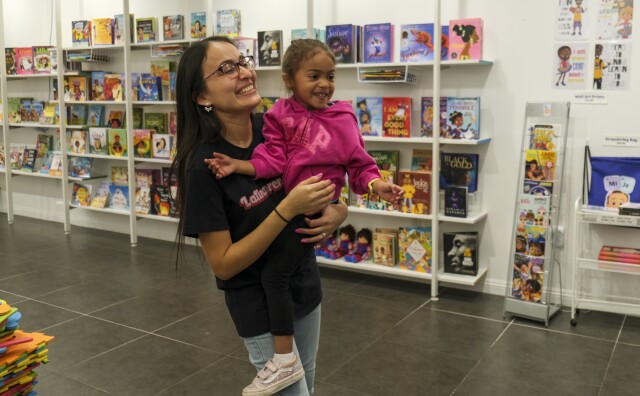In recent years, you may have gone to events around the L.A. area, including ones here at LAist, that started with a land acknowledgement. Institutions have been using these statements to recognize they’re operating on the homelands of the Gabrielino Tongva people, and to acknowledge the painful history of erasure and settler colonialism of Indigenous people.
“A land acknowledgement is great, but it's also just the first step into really building a relationship,” said Gabrielle Crowe, an outdoor educator and vice chair for the Gabrielino-Shoshone Tribal Council of Southern California.
And if you’ve been attending an event with young kids, words like “settler colonialism” also might fly right over their head. How might they be able to understand these statements and learn about the original stewards of the land they live on?
Land acknowledgements as a first step
Erika McLemore, who is Mvskoke-Seminole and a community manager at Tinkergarten, an outdoor educational program, incorporates kid-friendly land acknowledgments into her lessons.
“So what kids can understand is like, ‘the land where we're playing and exploring, it's always been someone's home,’” she said. “We name the people, and we try to find a few facts or stories that kids could connect to.”
-
We've compiled a list of places to visit and children's books to read to learn more about Indigenous communities.
For example, at her local park in Texas, there’s a big bush of beautyberry. She points to those native plants as having always been in the area, and how they were used by the Tonkawa tribe for medicine to treat stomach aches, and how the leaves were used for making bug repellant.
“It’s about gratitude and knowing and appreciation that gives us a starting place, to layer on other stuff too,” she said.
“Learn whose land you're on, find out where you live and find out who was on that land originally, but then maybe go into a deep dive of finding out what they ate, what they used in their homes, what they used for medicine,” said Cristin Spriggs of the Lumbee tribe in North Carolina and a former preschool teacher.
Connecting the past and present
Native people have always called this place home and continue to make their home here.
California is home to the largest Native American population in the country. There are more than 150 tribes in the state, some of which are not federally recognized.
“I feel like a lot of times that Indigenous people, especially the ones with ancestral ties to Los Angeles, are really talked about in the mindset of historical versus a living history,” Crowe, the outdoor educator, said.
Kids might feel frustrated about hearing about past injustices, but there are a number of ways for kids to learn about how to live in their present day lives.
“We can't go back and change what happened and the injustices, but we can move forward better in a more informed way,” said Kimberly Morales Johnson, who is Gabrielino Tongva, and serves as tribal secretary of the San Gabriel Band of Mission Indians.
“We can make sure that we speak up when we hear injustice,” she said.
Getting outside into nature and cultivating good stewardship
When Morales Johnson’s kids were young, she complemented teaching about justice with getting them outside into their gardens to learn about being good stewards. Kids can learn about the native plants and animals that inhabit that land.
“I'm a big proponent of going and getting a mortar and pestle and showing kids how you crack nuts,” she said. “Having a relationship with Mother Earth and talking about the importance of the gifts that Mother Earth [gives].”
At Anawakalmekak, an Indigenous charter school in El Sereno, community members can participate in landtending events of 12 acres that were recently returned to the Gabrielino Shoshone Tribal Nation of Southern California. People come out to weed, help spread mulch, and plant native plants.
“It gives us an opportunity to talk about the coyotes, and to talk about the ground squirrels, and to talk about the rabbits, and to share what our names are and our languages are for, for those children, and to have a different sense of relationship to understanding the sense of place that they can have here — as residents in this territory that's still occupied,” said Marcos Aguilar, head of school at Anawakalmekak.
Kids can understand difficult subjects
Terms like “settler colonialism” and “displacement” might not be in young kids’ vocabulary yet, but the concepts of fairness and exclusion become clear at a young age.
“Even preschoolers, they come home and you ask them how their day was and they're like, ‘Oh, so and so wasn't very kind to me or whatever, or they didn't let me come play,’” Spriggs, the former preschool teacher, said.
Spriggs says you can explain these concepts using feelings they currently understand — about being left out of spaces when playing with others.
McLemore, the outdoor educator, says young kids can understand hard truths.
“You can say, ‘there have been times where our country has done some terrible things.’ And if [tribes] were relocated, you can say, ‘the tribe was forced to move somewhere else, even though this has always been their home,’” said McLemore. “It's OK to say, ‘That doesn't sound fair, huh? That sounds hard. Would we want to treat someone that way now? No.’”
Aguilar, of the charter school, says that in many ways the youngest children are most open to deepening relationships with the places they live and the people they live among.
“I think it’s important for parents to not shy away,” he said. “Dealing with questions of genocide and colonization and ongoing oppression is definitely not something easy for young children to understand, but what we can teach them to understand is how to love other people. And to not ignore that there are these Indigenous peoples that continue to live here that we ought to also love.”
K-12 reporter Mariana Dale contributed to this article.










